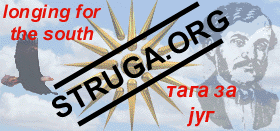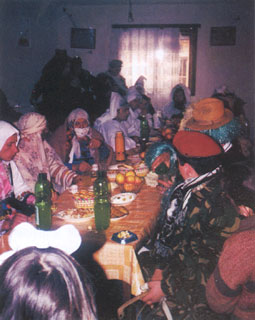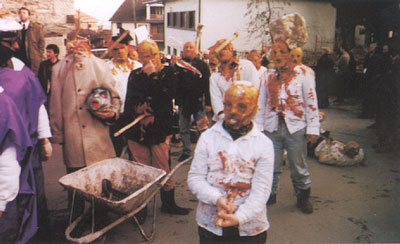
 |
The carnival in Vevchani |
 |
Every year on January 13-14 a masked carnival is held in the village of Vevchani to the north of Struga. The carnival is an Orthodox celebration of the New Year's Eve (according to the old Julian calendar) highlighted by a mask procession of local groups. Precisely, the carnival is held in honor of the great Christian holiday “St. Vasilij” (St. Basil) commonly known as Vasilitsa that marks the beggining of the new year (January 14) according to the Julian calendar. At the same time the carnival highlights the fact that some pagan rituals are still marking the cultural living of the local population. Young people dressed in ritual clothing and with masks on their faces, perform old magic rituals and blessings in order to have good health and good harvest througout the year. |
|
It is said that the traditional masked carnival in Vevchani is more than 1400 years old, i.e., as old as Vevchani itself as the villagers proudly exclaim. This carnival is different from other world carnivals by its characteristics, secrecy, archaic manner and sense of improvisation. During the carnival the whole village transforms into a kind of theatre during the carnival happenings, because every street is a stage, where masked persons perform their dances. Masks related to the actual happenings in the country and in the world take part in the carnival. Visitors from surrounding places and from other towns in Macedonia and abroad attend the village in large numbers during the carnival. Most of the masks (except the traditional ones) are kept in secrecy until the last moment. |
 |
 Visiting Vasilichari. |
The carnival begins on January 13
at 14.00h with a parade of the masked villagers commonly known as Vasilichari. This part of the
carnival is known as “Hello Vasilichari” and lasts throughout the rest of the day including
the night. The whole village turns into a scene where the masked play their roles in every
street and alley. The masked groups will first pass through the streets of Vevchani and then
starting from Gorno and Dolno Maalo will visit all the households in order to wish a happy new
year to the hosts. Every household gives to the visiting Vasilichari presents and money
that is used for development of the Vevchani community. |
|
Around 13.00h everybody will gather in the centre of Vevchani and here the nation-wide festivity takes place. With the traditional Vasilitsa folk dance in the center of the village, the carnival festivities in Vevchani are closed. Then the people will take off their masks and will burn them, as it is believed that in this manner the evil will disappear. The traditional masks of the carnival include 'the bride and groom', 'the friends of the groom' and 'the stupid August'. "These are not baptized days, so it is assumed that many evil spirits wander around us. The aim of the brothers is to protect the bride and the groom, who symbolize the fertility. The main weaponry is the mask, which should be very scary," Ilija Kalanovski the author of the book "Vevchani Carnival" explains. |
 The traditional wedding scene. |
The masks of the Vevchani carnival are systematized in the following categories: antropomorph, zoomorph, zooantropomorph, ethnic and terriomorph groups, all of them typical for this region. The people of Vevchani joke that during the carnival there are also some unpleasant things. "The ones who suffer the most are the pigs, homemade wine and brandy and the dogs" they say. Around 500 masked villagers take part in the carnival yearly. Officially, women don’t participate in the carnival, but still they too wear masks.
 Philharmonic orchestra. |
 War. |
 |
Every year through the carnival Vevchani offers its recognizable image: rich landscape and vivid mosaic of folklore, masks, originality and tradition. The villagers continue the primordial tradition: love yourself and do not give your village to anyone. Let the flow of life go on with all of its richness. Everybody with roots from Vevchani comes there in this period to take part in the carnival, to present the beautiful Macedonian folklore and custom. The entire village plays the role of a Vasilichar, who comes from the top of the mountain, fills water from the springs and sprinkles it with the flower/plant Vasilicharka on the houses, streets and people in the village, for the purpose of expelling the evil spirits, and introducing peace, unity and love even in the roughest of hearts.
Starting from 1993, Vevchani with its carnival is a member of the Worlds Association of Carnival cities.
Related articles: